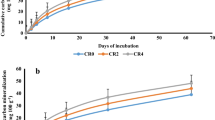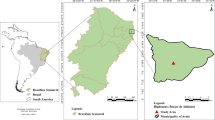Abstract
Soils, especially managed agricultural soils, have the potential to sequester carbon (C) and contribute to the mitigation of GHGs emissions. Increasing the amount of organic matter addition to soils may not only mitigate GHG emissions, but also benefit agricultural productivity through improvements in soil health and environmental quality. One potential method for increasing the amount of C held in agricultural soil is through conversion of conventional tillage practices to conservation tillage practices that reduce tillage and retain crop residues. Vertisols in India occupy 8.1% of the total geographical area of the country and are generally low in organic carbon content, but these soils have great potential to increase the soil organic carbon (SOC) level. Improvement in SOC content in these soils through traditional/conventional soil management practices is very difficult, as it has already attained the equilibrium level. One of the most attainable pathways to improve and sequester SOC content in this soil is through either regular addition of organic manures such as farmyard manure, compost or crop residues or by switching traditional tillage practices to no-tillage or other forms of conservation tillage. Several long- and short-term field studies on Vertisols reported that management strategies, such as no-tillage (NT) and reduced tillage (RT) with residue retention, played a significant role in increasing SOC concentration and favouring aggregate stability. Adoption of conservation tillage practices resulted in an improvement of surface soil aggregation and an increase in the proportion of macroaggregates compared to conventional tillage. Conservation tillage increases the percentage of carbon-rich macroaggregates in the soil particularly in the surface layers, resulting in sequestration of more carbon into soil stabilized through physical protection. More aggregate-C in large and small macroaggregates favoured better aggregation under conservation tillage than that under conventional tillage, which suggested that macroaggregates are sensitive to changes in the soil microbial community associated with short-term conservation management practices. Conservation tillage also resulted in stratification of SOC and available nutrient levels in soil. Conservation tillage in tropical Vertisols could be a useful technology to partially mitigate the deleterious effect of climate change through sequestration of carbon into the soil and reduction of greenhouse gas emission from agricultural activities to atmosphere. It also improves soil health, its resilience to extraneous stresses and the sustainability of agricultural production system.
Access this chapter
Tax calculation will be finalised at checkout
Purchases are for personal use only
Similar content being viewed by others
References
Barbara V, Poma I, Gristina L, Novara A, Egli M (2012) Long-term cropping systems and tillage management effects on soil organic carbon stock and steady state level of C sequestration rates in a semiarid environment. Land Degrad Dev 23:82–91
Bhattacharyya T, Sarkar D, Sehgal JL, Velayutham M, Gajbhiye KS, Nagar AP, Nimkhedkar SS (2009) Soil taxonomic database of India and the States (1:250,000 scale), NBSSLUP, Publication No. 143, pp 266
Bot A, Benites J (2005) The importance soil organic matter: key to drought-resistant soil sustained food production, FAO soils bulletin, vol 80. FAO, Rome
Chen H, Hou R, Gong Y, Li H, Fan M, Kuzyakov Y (2009) Effects of 11 years of conservation tillage on soil organic matter fractions in wheat monoculture in Loess Plateau of China. Soil Tillage Res 106:85–94
Derpsch R, Friedrich T (2009) Global overview of conservation agriculture adoption. In: Proceedings of the 4th world congress on conservation agriculture, New Delhi, pp 429–438
Ding G, Novak JM, Amarasiriwardena D, Hunt PG, Xing B (2002) Soil organic matter characteristics as affected by tillage management. Soil Sci Soc Am J 66:421–429
Franzluebbers AJ (2002) Soil organic matter stratification ratio as an indicator of soil quality. Soil Tillage Res 66:95–106
Griffith DR, Moncrief JF, Eckert DJ, Swan JB, Breitbach DD (1992) Crop response to tillage systems. In: Conservation tillage systems and management: crop residue management with no-till, ridge-till, mulch-till, 1st edn. MWPS-45. Mid West Plan Service, Ames, Iowa, pp 25–33
Guo LB, Gifford RM (2002) Soil carbon stocks and land use change. Glob Chang Biol 8:345–360
Hassink J (1995) Decomposition rate constants of size and density fractions of soil organic matter. Soil Sci Soc Am J 59:1631–1635
Hati KM, Mandal KG, Misra AK, Ghosh PK, Bandyopadhyay KK, Acharya CL (2006) Effect of inorganic fertilizer and farmyard manure on soil physical properties, root distribution, and water-use efficiency of soybean in Vertisols of Central India. Bioresour Technol 97:2182–2188
Hati KM, Swarup A, Dwivedi AK, Misra AK, Bandyopadhyay KK (2007) Changes in soil physical properties and organic carbon status at the topsoil horizon of a vertisol of Central India after 28 years of continuous cropping, fertilization and manuring. Agric Ecosyst Environ 119:127–134
Hati KM, Chaudhary RS, Mohanty M, Singh RK (2013) Impact of conservation tillage on soil organic carbon content, its distribution in aggregate size fractions and physical attributes of Vertisols. In: Kundu S, Manna MC, Biswas AK, Chaudhary RS, Lakaria BL, Subba Rao A (eds) IISS contribution in frontier areas of soil research. Indian Institute of Soil Science, Bhopal, pp 187–200
Hati KM, Chaudhary RS, Mandal KG, Bandyopadhyay KK, Singh RK, Sinha NK, Mohanty M, Somasundaram J, Saha R (2015a) Effects of tillage, residue and fertilizer nitrogen on crop yields, and soil physical properties under soybean-wheat rotation in Vertisols of Central India. Agric Res 4(1):48–56
Hati KM, Chaudhary RS, Mohanty M, Biswas AK, Bandyopadhyay KK (2015b) Short-term tillage and fertilization impacts on soil organic carbon, aggregate stability and yield of soybean-wheat system in deep black soils of Central India. J Indian Soc Soil Sci 63(1):1–12
Jha P, Garg N, Lakaria BL, Biswas AK, Rao AS (2012) Soil and residue carbon mineralization as affected by soil aggregate size. Soil Tillage Res 121:57–62
Jobbagy EG, Jackson RB (2000) The vertical distribution of soil organic carbon and its relation to climate and vegetation. Ecol Appl 10:423–436
Kushwah SS, Reddy DD, Somasundaram J, Srivastava S, Khamparia SA (2016) Crop residue retention and nutrient management practices on stratification of phosphorus and soil organic carbon under soybean-wheat system in Vertisols of Central India. Commun Soil Sci Plant Anal 47:2387–2395
Lal R (2004) Soil carbon sequestration to mitigate climate change. Geoderma 123:1–22
Lal R (2006) Enhancing crop yields in the developing countries through restoration of the soil organic carbon pool in agricultural lands. Land Degrad Dev 17:197–209
Lal R, Kimble JM (1997) Conservation tillage for carbon sequestration. Nutr Cycl Agroecosyst 49:243–253
Manna MC, Swarup A, Wanjari RH, Ravankar HN, Mishra B, Saha MN, Singh YV, Sahi DK, Sarap PA (2005) Long-term effect of fertilizer and manure application on soil organic carbon storage, soil quality and yield sustainability under sub-humid and semi-arid tropical India. Field Crop Res 93:264–280
McCallister DL, Chien WL (2000) Organic carbon quantity and forms as influenced by tillage and cropping sequence. Commun Soil Sci Plant Anal 31:465–479
McCarty GW, Lyssenko NN, Starr JL (1998) Short-term changes in soil carbon and nitrogen pools during tillage management transition. Soil Sci Soc Am J 62:1564–1571
Paustian K, Collins HP, Paul EA (1997) Management controls on soil carbon. In: Paul EA (ed) Soil organic matter in temperate agro-ecosystems, long-term experiments in North America. CRC Press, Boca Raton, pp 15–49
Six J, Elliott ET, Paustian K (2000) Soil macroaggregate turnover and microaggregate formation: a mechanism for C sequestration under no tillage agriculture. Soil Biol Biochem 32:2099–2103
Six J, Callewaert P, Lenders S, De Gryze S, Morris SJ, Gregorich EG, Paul EA, Paustian K (2002a) Measuring and understanding carbon storage in afforested soils by physical fractionation. Soil Sci Soc Am J 66:1981–1987
Six J, Feller C, Denef K, Ogle SM, de Moraes Sa JC, Albrecht A (2002b) Soil organic matter, biota and aggregation in temperate and tropical soils—effects of no-tillage. Agronomie 22:755–775
Six J, Conant RT, Paul EA, Paustian K (2002c) Stabilization mechanisms for soil organic matter: implications for C saturation of soils. Plant Soil 141:155–176
Somasundaram J, Chaudhary RS, Awanish K, Biswas AK, Sinha NK, Mohanty M, Hati KM, Jha P, Sankar M, Patra AK, Chaudhari SK (2018) Effect of contrasting tillage and cropping systems on soil aggregation, carbon pools and aggregate-associated carbon in rainfed Vertisols. Eur J Soil Sci 69:879–891. https://doi.org/10.1111/ejss.12692
Stewart CE, Plante AF, Paustian K, Conant RT, Six J (2008) Soil carbon saturation: linking concept and measurable carbon pools. Soil Sci Soc Am J 72:379–392
Swaminathan MS (2000) Science in response to basic human needs. Science 287(5452):425
Tisdall JM, Oades JM (1982) Organic matter and water-stable aggregates in soil. J Soil Sci 33:141–163
West TO, Post WM (2002) Soil organic carbon sequestration rates by tillage and crop rotation: a global data analysis. Soil Sci Soc Am J 66:1930–1946
Author information
Authors and Affiliations
Editor information
Editors and Affiliations
Rights and permissions
Copyright information
© 2020 Springer Nature Singapore Pte Ltd.
About this chapter
Cite this chapter
Hati, K.M. et al. (2020). Soil Organic Carbon Dynamics and Carbon Sequestration Under Conservation Tillage in Tropical Vertisols. In: Ghosh, P., Mahanta, S., Mandal, D., Mandal, B., Ramakrishnan, S. (eds) Carbon Management in Tropical and Sub-Tropical Terrestrial Systems. Springer, Singapore. https://doi.org/10.1007/978-981-13-9628-1_12
Download citation
DOI: https://doi.org/10.1007/978-981-13-9628-1_12
Published:
Publisher Name: Springer, Singapore
Print ISBN: 978-981-13-9627-4
Online ISBN: 978-981-13-9628-1
eBook Packages: Earth and Environmental ScienceEarth and Environmental Science (R0)




